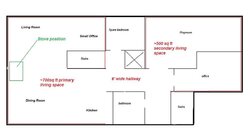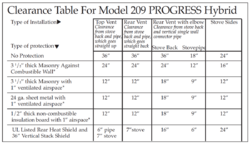Hey guys,
First time prospective stove owner looking for some advice. For the past 7 years I've been heating my home with an old smoke dragon wood burning furnace (forced air). It's been gobbling up LOTS of wood so I'm ready to move to another solution. I considered getting another basement furnace but then thought that a wood stove in the living space would be better.
So, my search began. Here were my criteria ...
Wood Stock Progress Hybrid
Pros:
Blaze King Ashford 30
Pros:
Wood Stock Ideal Steel
Pros:
So, this is what I've got so far. I'd be really interested in hearing from people who had these particular stoves. I'd also be open to any suggestions (even if it's a stove that I haven't considered).
Maybe some of you think that I should just buy a new wood furnace for the basement. I'd be interested in hearing pros and cons of that too.
Thanks for any thoughts you can give ...
-dromlyn

First time prospective stove owner looking for some advice. For the past 7 years I've been heating my home with an old smoke dragon wood burning furnace (forced air). It's been gobbling up LOTS of wood so I'm ready to move to another solution. I considered getting another basement furnace but then thought that a wood stove in the living space would be better.
So, my search began. Here were my criteria ...
- Will heat the roughly 1400 sq ft of down stairs in my house [see diagram below]. I also have an additional 700 sq ft in a second floor that I'd like to keep at roughly 60 degrees.
- Won't cook us out of our primary living space. slow heat release is good.
- Won't leave a huge "hearth-print". the primary 700 sq ft is where our living room, kitchen and entryway are located. So it shouldn't take up a huge amount of space.
- Cook-top. I live in the mountainous regions of central PA so we do get power outages occasionally.
- Looks. It'd be an added benefit if it looked halfway decent in our living room.
- Price isn't too much of a concern. But if it was a draw between two stoves it'd be worth saving 500-1000 bucks.
Wood Stock Progress Hybrid
Pros:
- SIDE LOADING DOOR is wonderful because I have more room side to side than I do front to back.Soapstone for "softer heat".
- I like the intentionally dedicated cooktop.
- Rear venting
- Customer Service.
- EXPENSIVE
- weight
- the 14 hour burn time is wonderful but the ashford is claiming 30 hours (is that real?)
Blaze King Ashford 30
Pros:
- BURN TIME (again, is that real?),
- price is better than PH,
- I think it's a more attractive looking stove.
- FRONT LOADER requires more hearth space out front, eats up livnig space
- Doesn't appeart to have a dedicated cook top (true?).
- Shape of firebox only allows 18" logs. Can I get enough wood in to heat all 2100 sq ft. of house?
Wood Stock Ideal Steel
Pros:
- PRICE,
- dedicated cook top.
- Big firebox, allows 22" logs.
- Rear venting.
- Front loading,
- not crazy about how it looks (not terrible though).
So, this is what I've got so far. I'd be really interested in hearing from people who had these particular stoves. I'd also be open to any suggestions (even if it's a stove that I haven't considered).
Maybe some of you think that I should just buy a new wood furnace for the basement. I'd be interested in hearing pros and cons of that too.
Thanks for any thoughts you can give ...
-dromlyn

Last edited by a moderator:



